Vintage Singer sewing machine welcomed in the family | #LRCrafts - DIY Passion: if you can think it, you can make it
When I was a child, a vintage Singer treadle sewing machine adorned our home. Though it had ceased to function, it held a special place in our hearts, doubling as both furniture and a reminder of my granny’s farm in the countryside. As a child, I was enchanted by the rhythmic motion of the treadle, the only part of the machine that still functioned. When we left our old home, unfortunately it was lost to us, but its memory lingered in my mind, especially as I discovered the joys of sewing myself.
So when my mother mentioned a local gentleman selling his aunt’s Singer sewing machine, its resemblance to our old family relic piqued my interest. Upon seeing it, I was struck by its familiar charm and impeccable state. It’s been treated with deep care and was in perfect working condition. With my parents, we agreed on taking it home with us, to find her a place where we could put her to good use again.
Bringing it home felt like reuniting with an old friend, but with a newfound purpose in mind. The idea of restoring this piece of history and breathing new life into it filled me with excitement and anticipation.
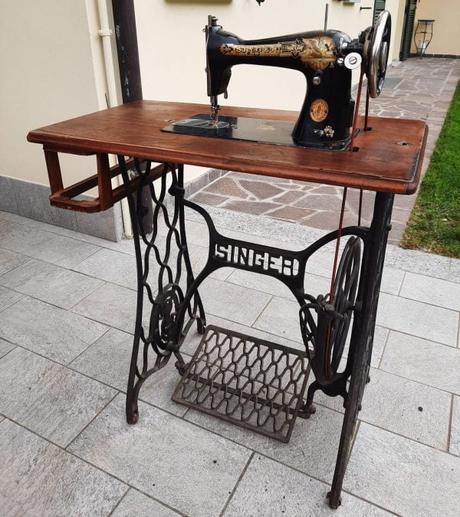
Table of contents
About the long history of Singer Manufacturing Company
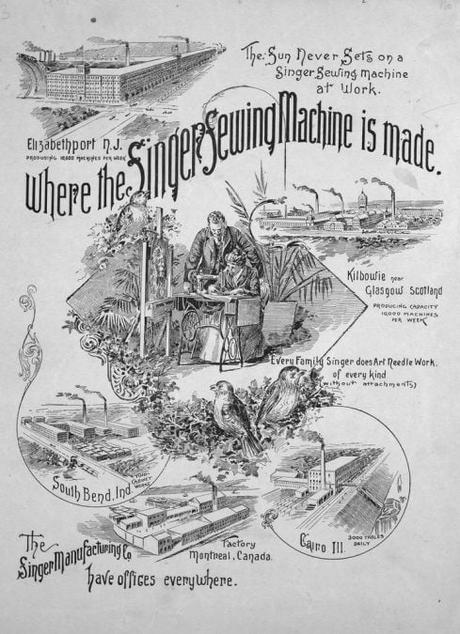 Advertisement of Singer Manufacturing Company, 1891Image from https://www.library.jhu.edu/
Advertisement of Singer Manufacturing Company, 1891Image from https://www.library.jhu.edu/Singer sewing machines have a rich history that dates back to the mid-19th century. Iin 1850 in Boston Isaac Merritt Singer manufactured his first straight stitch sewing machine at a small machine shop in Boston: it was named the Standard 1. Next year, he issued a patent for the first Singer brand sewing machine.
Singer’s original design, which was the first practical sewing machine for general domestic use, incorporated the basic eye-pointed needle and lock stitch developed by Elias B. Howe, who won a patent-infringement suit against Singer in 1854. The suit did not prevent Singer from manufacturing his machine, however: he consolidated enough patents in the field be able to engage in mass production, and by 1860 the company was the largest manufacturer of sewing machines in the world.
The Singer Manufacturing Company got its current name in 1863, upon moving to New York, and quickly became a household name, revolutionizing the way people approached sewing. With its innovative designs and mass production techniques, Singer made sewing more accessible to people of all backgrounds.
It brought a deep revolution in the sewing industry. In the 1860s, 400 Singer machines were able to do any piece of work that may be done by 2000 workers. It was way faster than stitching by hand, as I suppose any of you know by now. But can you even imagine the revolution at the time? No wonder Singer was granted with the first prize in sewing machines at World’s Fair in Paris in 1855.
Singer Manufacturing Company demonstrated the first workable electric sewing machine at the Philadelphia electric exhibition in 1885. It then began mass-producing domestic electric machines in 1910. Singer was also a marketing innovator, and was a pioneer in promoting the use of installment payment plans, which had a profound effect on consumer sales. Even people who could not afford to buy a sewing machine could have one.
During the early 20th century, Singer sewing machines were at the forefront of domestic and industrial sewing. Their reliability, durability, and ease of use made them a staple in homes, factories, and even aboard ships. The Singer Model 15, introduced in 1895 and produced until the 1960s, is a testament to the company’s commitment to quality craftsmanship.
Singer opened its first free sewing course in New York City, being the first company to do this. It provided training on embroidery and tailored sewing.
The company assumed the name Singer Company in 1963, a year after introducing the first zigzag machine. In 1990, Singer teamed up with Nintendo to manufacture a fully computerised sewing machine, that was was offered for sale just one year later.
In 2004 the sewing business and the Singer trademarks were sold to a private U.S. investment firm. In 2006 it became part of SVP Worldwide, which combined Singer with Husqvarna Viking and PFAFF, two other major sewing machine producers.
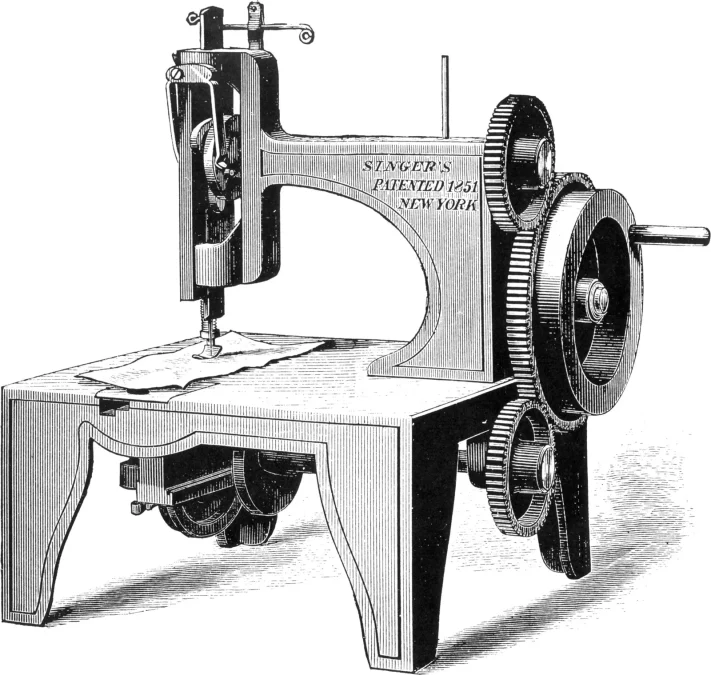 Isaac M. Singer's first sewing machine, as patented in 1851, illustrated in "Genius Rewarded or, The Story of the Sewing Machine", 1880
Isaac M. Singer's first sewing machine, as patented in 1851, illustrated in "Genius Rewarded or, The Story of the Sewing Machine", 1880Did you know about Singer's jingle?
In 1891, Singer became one of the first companies which used a “jingle” music in an advertising campaign. The song “Merry Singer”, composed by Henri Le Verne dedicatedly for the company, made great contributions to reputation of Singer.
“The sun never sets on a Singer sewing machine at work!”.
The jingle scoreOur vintage Singer sewing machine
The serial number
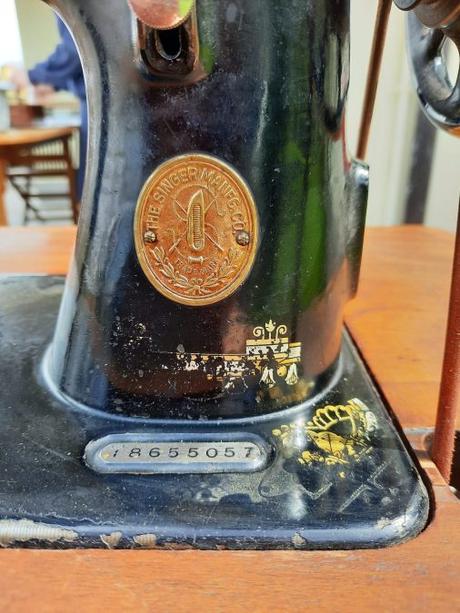
When we went in our fellow countryman’s garage to see the sewing machine for the first time, the first thing I did was looking for the serial number. I knew that each Singer sewing machine has one, since the first one ever produced, and from this you can find out the year this specific machine was produced.
There are several charts online to refer to, as accurate as they can be, because back in time all the records were on paper, subject to deterioration and loss of information. They can give a good estimate, though. The best charts I ever found are those by ISMACS: I like them mainly because they are on web pages rather than pdf files, easier to consult on mobile devices. Sometimes I happened to find vintage Singer machines at thrift markets, and anytime I checked the serial number online to estimate the date of production.
Serial numbers from the 20th century also have a letter: it can be useful to determine the factory of production.
As for our Singer, I checked and double checked the serial number using different sources: it was made in 1933 in Kilbowie (Scotland). The building of this factory, I learned, started in 1882 and was completed in 1885. Production began in 1884, and by the following year Singer’s Kilbowie Factory was the largest factory in the world, shipping sewing machines all around the globe. Even to Italy. In 1900 the factory was renamed Clydebank Factory, so it’s usually referred to with this denomination.
Find info on your sewing machine from Serial Number
Since I struggled trying to figure out the model of my vintage Singer sewing machine from the serial number, I thought I could make things easier for other enthusiasts.
I made a searchable database where you can quickly identify key information about your machine, like model, production year or factory, with just a few clicks. Just input your machine’s serial number and get the available data!
Search for a Serial NumberDetermining the model
Well, what I didn’t know was that finding the model was trickier. Each model has its own features and, as I was browsing online to find manuals to operate the machine correctly, I saw that not all the charts with serial numbers and date had also the indication of the model.
Before finding the good ISMACS charts, I delved even deeper in the history of Singer models to figure out my newly acquired machine model, and therefore the correct manual to use. Since my plan was to use the machine, I needed to figure out how to thread it correctly, how to keep it in good working order, how to wind the bobbin and more.
The official Singer website FAQ page was a good introduction, but not enough to be sure. The most useful and complete resource gave a step-by-step method to determine the model. Not as easy as I thought at the beginning! I double checked with an easy visual guide, just in case. It happened the model 15 is the easiest to spot: as described, my machine has the tension adjustment knob on the metal plate on the very left end of the machine. Also, it has a separate removable bobbin case, which other models don’t have.
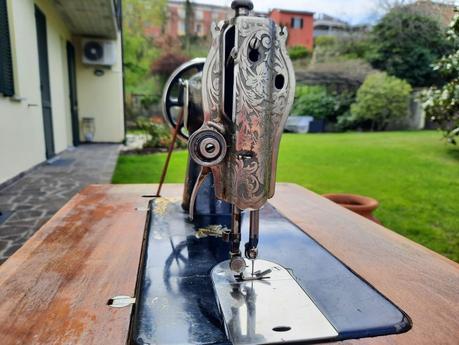 The tensioner unit of my Singer sewing machine from 1933
The tensioner unit of my Singer sewing machine from 1933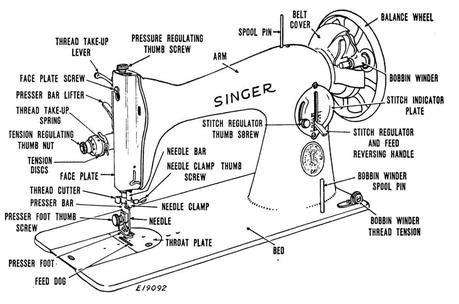 Diagram of the different parts of a Singer class 15
Diagram of the different parts of a Singer class 15Actually, I should say “class 15”. The complete model number has the first number, the “class“, to indicate the basic design of the mechanism, followed by a letter as a location code to indicate the factory, and then completed by another number to specify the sub-version, used to indicate optional features and/or changes over time. Machines of the same sub-version are identical, no matter where they were made, but those of different sub-versions have some different parts, even if made in the same factory.
I was not able, so far, to determine the sub-version of my machine: it was common practice to abbreviate full model numbers to either just the class number or to the class plus location code. So my machine is a 15K, class 15 produced in Kilbowie. It’s a pity the majority of older Singer machines haven’t a plate with the full model number, similar to the silver plate with the serial number.
An interesting feature I love about this machine are the decals. They are faded in some points, where the hands of the seamstress touched them the most, but you can still see the beautiful details and read the text.
On the right on the main body you see a Sphinx, that gives the name to this kind of decoration. These decals, also known as “Memphis” or “Egyptian” decal set, first appeared in the 1890’s. They were used on the class 15 and class 27 up to the 1950’s.
I also found out that on Ebay you can find decal sets on sale to replace them and renew them. I love the idea of restoring the machine to its initial splendour, but I have to dive deeper into the matter before thinking of buying such a set… If someone has experience on using those decal sets, please tell me your opinion about them!
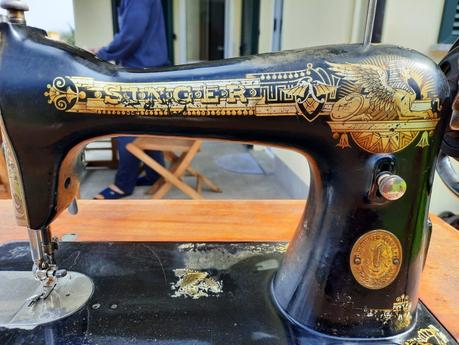 The Sphinx decals on the front of our Singer sewing machine
The Sphinx decals on the front of our Singer sewing machineFind out info on your Singer
Looking for info about my Singer sewing machine got me fascinated about all you can learn about those machines. So I created a searchable database to help other machine owners like me. Where reliable records exist, you can input the serial number of your machine and find out model, factory, period of production.
Search the databaseCleaning the machine
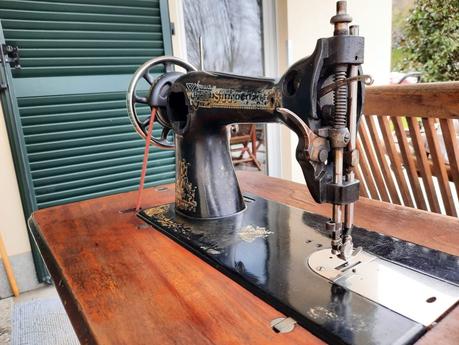

After the death of the previous owner, the machine had rested unused for a couple of years, so the first thing we did was a thorough cleaning.
My husband oiled all the wooden parts and fixed the cover, where the wood was detached in a corner. We are pretty sure the cover was not the original one, but it seems pretty old nonetheless. We took care also of the drawer under the table, where we found a few treasures: a spare bobbin case, original screwdrivers, a lot (and I mean a lot!) of spare needles, a few bobbins with thread.
On the machine body itself we didn’t use water or cleaning products: we just gently removed dust not to ruin the decals.
I patiently cleaned all the treadle and the underside of the table. We also removed the metal plaques on the body of the machine, just the parts that were easy to reassemble: we were still without a manual while cleaning, so we didn’t want to damage the working parts.
What next?
After the cleaning, we positioned the machine in its new home in my parents’ countryhouse. Next time we go there for a weekend I’ll come with the manual so we can remove the parts we can for more cleaning and to oil the mechanisms. For sure, I also want to try it on a small test project. I’ll keep you posted!
Do you have any experience with vintage Singer machines? Any tips for restoring decals or cleaning old parts? We’re all ears! Share your stories, questions and advice in the comments below. Let’s swap sewing tales and inspire each other to create something beautiful with these timeless machines.
by Rici86.

